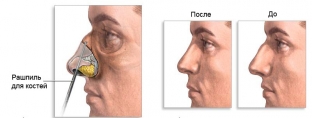One of the most important stages of rhinoplasty is the formation of the back of the nose. The bridge of the nose is precisely that part of it that forms the overall aesthetically attractive appearance of the nose. Nasal dorsum is formed only after interventions on the nasal septum, nasal turbinates and osteotomies, as these processes affect the height of the dorsum. Most patients who go to plastic surgeons for rhinoplasty want to have a straight, neat nose, and nose bridge correction helps to give it that look. To strengthen and shape the back of the nose, several types of transplants are used, which estet-portal.com
wants to talk about in more detailCartilage grafts – the best option for correcting the back of the nose
Today, the optimal material for the correction of the back of the nose in rhinoplasty is a cartilage graft, which allows to ensure complete harmony of aesthetic rhinoplasty with modern principles of transplantology. Most often, cartilage of the nasal septum is used to create a cartilage graft, less often the cartilage of the auricle and costal cartilages. The undoubted advantage of cartilage grafts is that they can be amenable to various changes: cartilage can be softened, broken, remodeled, sutured together, and so on. Cartilage grafts can be used both for contour rhinoplasty, that is, placed over the structural elements of the nose, and for strength, placed between or under the cartilage elements of the nose. Usually,
When are bone grafts used in rhinoplastyBone grafts are often used for defects in the bones of the nasal pyramid, as well as for large defects in the cartilaginous part of the back of the nose. Bone grafts are taken from the vomer, the bones of the cranial vault, the transverse plate of the ethmoid bone, the ribs and the ilium. Bone grafts are used to correct the back of the nose during rhinoplasty less frequently than cartilage grafts, due to some of their shortcomings. Bone grafts from the bones of the cranial vault and from the wing of the ilium must be fixed at the base with a screw or pin in order to prevent their displacement in the future. The disadvantage of bone grafts from the iliac wing is the formation of a pronounced postoperative scar in the donor area. In addition, bone grafts may undergo resorption over time,
 How fascial grafts are used to correct the bridge of the nose
How fascial grafts are used to correct the bridge of the nose







Add a comment